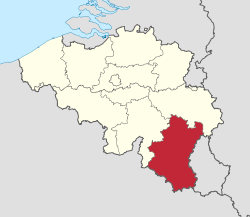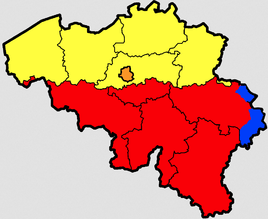Luxembourg (Belgium)
| Luxembourg Luxemburg (Dutch, German) | |||
|---|---|---|---|
| Province of Belgium | |||
| |||
 | |||
| Coordinates: 49°55′N 5°25′E / 49.92°N 5.42°ECoordinates: 49°55′N 5°25′E / 49.92°N 5.42°E | |||
| Country |
| ||
| Region |
| ||
| Capital | Arlon | ||
| Government | |||
| • Governor | Olivier Schmitz | ||
| Area | |||
| • Total | 4,443 km2 (1,715 sq mi) | ||
| Population (1 January 2017)[1] | |||
| • Total | 281,972 | ||
| • Density | 63/km2 (160/sq mi) | ||
| Website |
www | ||
Luxembourg (French: Luxembourg; Dutch: ![]()
It has an area of 4,443 km2 (1,715 sq mi), making it the largest Belgian province. At around 250,000 residents, it is also the least populated province, making it a relatively sparsely populated province in an otherwise very densely populated country.
It is significantly larger (70%) and much less populous than the neighbouring Grand Duchy of Luxembourg. About eighty percent of the province is part of the densely wooded Ardennes region. The southernmost region of the province is called Gaume or Belgian Lorraine (main city: Virton).
The Arelerland or Arlon region (in red on the following map of the province) alongside the border with the neighbouring Grand-Duchy of Luxembourg has the particularity that many residents speak Luxembourgish, closely related to German, instead of the Walloon variety of French spoken elsewhere in the province.
The province was separated from the neighbouring Luxembourg by the Third Partition of Luxembourg, de jure in 1830–31 by the Conference of London dealing with the consequences of the Belgian Revolution of 1830, de facto in 1839, after William I, King of the Netherlands and Grand-Duke of Luxembourg, agreed to its decisions and thus the province was given to the newly created Kingdom of Belgium.
Subdivisions
-fr.png)
Luxembourg province is divided into five administrative districts (French: arrondissements) containing a total of 44 municipalities (French: communes).
See also
References
- ↑ Population per municipality as of 1 January 2017 (XLS; 397 KB)
External links
| Wikivoyage has a travel guide for Luxembourg (Belgium). |
| Wikimedia Commons has media related to Luxembourg (Belgium). |


